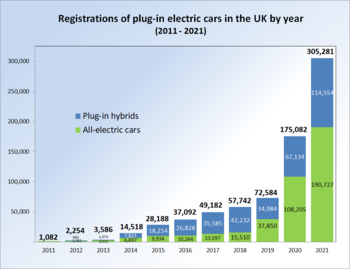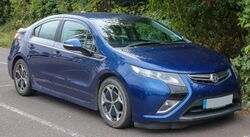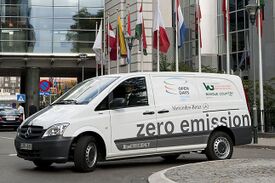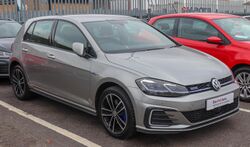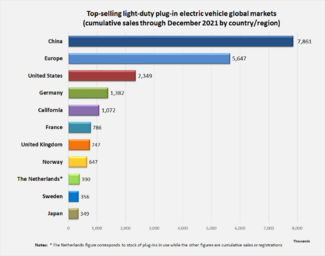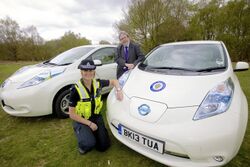Engineering:Plug-in electric vehicles in the United Kingdom
The adoption of plug-in electric vehicles in the United Kingdom is actively supported by the British government through the plug-in car and van grants schemes and other incentives.[3] Around 455,000 light-duty plug-in electric vehicles had been registered in the UK up until February 2021, consisting of about 215,000 all-electric vehicles and 240,000 plug-in hybrids.[4] Until 2019, the UK had the second largest European stock of light-duty plug-in vehicles in use after Norway.[5]
Statistics
A surge of plug-in car sales began in Britain in 2014. Total registrations went from 3,586 in 2013, to 37,092 in 2016, and rose to 59,911 in 2018.[SMMT 3][SMMT 7][SMMT 8] The market share of the plug-in segment went from 0.16% in 2013 to 0.59% in 2014, and achieved 2.6% in 2018.[SMMT 3][SMMT 4][SMMT 8]
(As of September 2018), the Mitsubishi Outlander P-HEV is the all-time top-selling plug-in car in the UK with almost 37,000 units registered, followed by the Nissan Leaf with nearly 24,000. Ranking third is the BMW 330e with more than 13,000 units, followed by the BMW i3 with 11,000.[4]
(As of January 2018), the UK had 19,108 public charging points at 6,703 locations, of which 4,391 were rapid charging points at 1,332 locations.[6]
Government support
Speaking at the G8 summit in 2008, British Prime Minister Gordon Brown announced plans for Britain to be at the forefront of a "green car revolution". Mr Brown suggested that by 2020 all new cars sold in Britain could be electric or hybrid vehicles producing less than 100 grams of CO2 per kilometre (5.7 oz(CO2)/mi).[7] In preparation for the introduction of mass-produced electric vehicles to Britain's roads, trials of electric cars took place from 2009, with further trials in cities across the UK from 2010. Local councils were invited to submit bids to become Britain's first "green cities". One example is Glasgow, where a Scottish consortium has been awarded more than £1.8 million to run a pilot electric car scheme from 2009 to 2011.[8]
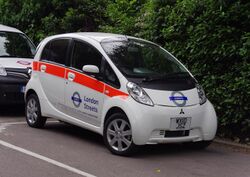
London mayor Boris Johnson also announced plans in April 2009 to deliver 25,000 electric car-charging places across the capital by 2015, in order to make London the "electric car capital of Europe". His target is to get 100,000 electric vehicles on to London's streets. Mr Johnson has also pledged to convert at least 1,000 Greater London Authority fleet vehicles to electric by 2015.[8][9] Transport for London also announced that all new taxis must be zero emissions capable by 2018.[10] (As of June 2014), there were about 3,000 plug-in electric vehicles in London, 3% of the mayor's goal, up from 1,700 electric cars in January 2009. The city also has only 1,408 charging points in operation, of which, only 57% were used in the first quarter of 2014.[10] (As of October 2015), Greater London postcode areas contain 8,000 electric vehicles according to the Driver and Vehicle Licensing Agency (DVLA).[11]
Nissan's Sunderland plant – the largest car factory in the UK – was granted a £20.7 million grant from the British government and up to £220 million from the European Investment Bank.[12][13][14] Production of the Nissan Leaf at the Sunderland plant began in March 2013.[15] The plant has the capacity to produce 60,000 lithium-ion batteries and 50,000 Leafs a year.[12] The UK produced Leaf are sold only in Europe has an improved driving range, lower price and a more European design.[16] The price of the 2013 Leaf produced in Sunderland is lower than the model built in Japan,[17][18] and Nissan is offering a battery leasing option for the three trims produced at Sunderland, which further reduced the purchase price by £5,000.[19][20]
(As of November 2013), the UK government had pledged £400 million to support the deployment of plug-in vehicles in the five years between March 2010 and March 2015. However, (As of September 2013), only £92 million had been spent and an additional of £44 million had been committed for projects up to March 2015, of which, £82 million were allocated for research and development; £16 million on infrastructure such as public charging points; and £25 million in consumer purchase incentives (Plug-in Car Grant). (As of November 2013), the UK has around 5,000 public charging points, of which, only 200 are quick chargers.[3] By April 2014 the UK was the leader in quick-charging deployment in Europe, with 211 CHAdeMO charging stations available across the country.[21]
As a result of lower than initially expected electric and plug-in hybrid vehicle sales, in January 2014 the UK government launched the "Go Ultra Low" national campaign in partnership with five of the largest manufacturers of plug-in electric vehicles, BMW, Nissan, Renault, Toyota and Vauxhall. The campaign has a cost of £2.5 million and its objective is to promote the benefits of electric and plug-in hybrid cars to buyers. The government classifies any car emitting less than 75g/km of CO
2 as ultra-low emission. The British government also announced its commitment to invest £9 million to install more rapid charge-points to make motorway journeys by electric car feasible. According to Nicholas Clegg, Deputy Prime Minister, “Our clear objective is to move the car fleet in this country to ultra low-emission vehicles by 2040 and to put money and policy money behind it."[22]
In July 2014 Baroness Kramer, Minister of State for Transport, announced that all of the UK government's fleets would be supplied with funding to introduce electric vehicles. The "Ultra Low Emission Vehicle Readiness Project", funded with £5 million, is the first step towards making all government vehicles electrically powered. Central government fleets were to benefit first, with plans to bring in over 150 plug-in cars and vans. The Government Car Service, which had 85 vehicles used by ministers, was the initial target with electric cars expected to be in operation by the third quarter of 2014. A second phase would provide funds for the public sector in general to purchase more electric vehicles. Beneficiary agencies include the National Health Service, councils and police forces.[23] In October 2019, the Labour Party said it would aim to ban the sale of new non-electrified cars by 2030.[24]
Purchase incentives
In January 2009, transport secretary Geoff Hoon said the British government would make £250 million (~US$375 million) available for consumer incentives to bring electric cars to market in the UK.[9] The plug-in grant scheme was first announced in January 2009 by the Labour Government. The coalition government, led by David Cameron, took office in May 2010 and confirmed their support of the grant on 28 July 2010. This confirmed that £43 millionwould be available for the first 15 months of the scheme, with the 2011 Spending Review confirming funding for the programme for the lifetime of the Parliament of around £300 million (~US$450 million).[25][26][27]
Two subsidy programs were implemented, the Plug-in Car Grant, from January 2011, and the Plug-In Van Grant, from February 2012. Both offer buyers of eligible vehicles a purchase subsidy discounted at the point of purchase.
Plug-in Car Grant
The Plug-in Car Grant programme started on 1 January 2011 and is available across the UK. The programme reduces the up-front cost of eligible cars by providing a 25% grant towards the cost of new plug-in cars, capped at £5,000 (US$7,450).[28][29] From 1 April 2015, the purchase price cap was raised to cover up to 35% discount of the vehicle's recommended retail price, up to the same £5,000 limit. This change means electric cars priced under £20,000, such as the Renault Zoe, are able to take advantage of most or all of the £5,000 discount.[30] Both private and business fleet buyers are eligible for this grant, which is received at the point of purchase.[28]
The subsidy programme is managed in a similar way to the grant made as part of the 2009 Car Scrappage Scheme, allowing consumers to buy an eligible car discounted at the point of purchase, with the subsidy claimed back by the manufacturer afterwards.[28][29]
Evolution
The government announced in April 2014 that funding for the full grant of up to £5,000 would remain in place until either 50,000 grants have been issued or 2017, whichever came first.[30][31] Nevertheless, as forecasts estimated that the scheme would reached its 50,000 limit around November 2015, the government announced in August 2015 that the grant would continue until at least February 2016 for all plug-in cars with CO
2 emissions of 75 g/km of under.[32] The government also announced that a minimum of £200 million (~US$300 million) had been made available to continue the Plug-in Car Grant.[33]
The programme was extended in February 2012 to include plug-in vans. Van buyers can receive 20% – up to £8,000 – off the cost of a plug-in van.[34]
As plug-in car sales surged during 2014 and 2015, the PICG was extended until March 2018. The maximum grant was reduced to £4,500, and the amount granted varies according to emission levels. Hydrogen fuel cell cars became eligible for the grant. Models with a list price of more than £60,000 are no longer eligible for the grant.[35][36] The Plug-In Van Grant scheme was extended in October 2016 to make electric trucks above 3.5 tonnes eligible for grants of up to £20,000.[37]
(As of September 2018), a total of 176,962 eligible cars have benefited from the subsidy since its launch in 2011,[38] and at the same date the number of claims made through the Plug-in Van Grant scheme was 5,218 since the launch of the programme in 2012.[39]
In 2018 the PICG was reduced from £4500 to £3500,[40] and in March 2020 it was cut to £3000.[41]
Eligibility
Vehicles eligible for the subsidy must meet the following criteria:[28][42]
- Vehicle type: Only ultra-low emission cars are eligible (vehicle category M1). Motorbikes, quadricycles and vans are not covered.
- Carbon dioxide exhaust emissions: Vehicles must emit equal or less than 75 grams of carbon dioxide (CO2) per kilometre driven.
- Range: Electric vehicles (EVs) must be able to travel a minimum of 70 mi (110 km) between charges. Plug-in hybrid electric vehicles (PHEVs) must have a minimum all-electric range of 10 mi (16 km).
- Minimum top speed: Vehicles must be able to reach a speed of 60 mph (97 km/h) or more.
- Warranty: Vehicles must have a three-year or 60,000 miles (97,000 km) vehicle warranty (guarantee) and a 3-year battery and electric drive train warranty, with the option of extending the battery warranty for an extra two years(‘drive train’ means the parts that send power from the engine to the wheels. These include the clutch, transmission (gearbox), drive shafts, U-joints and differential).
- Battery performance: Vehicles must have either a minimum five-year warranty on the battery and electric drive train as standard, or extra evidence of battery performance to show reasonable performance after three years of use
- Electrical safety: Vehicles must comply with certain regulations (UN-ECE Reg 100.00) that show that they are electrically safe.
- Crash safety: To make sure cars will be safe in a crash, they must either have: EC whole vehicle type approval (EC WVTA, not small series) or evidence that the car has appropriate levels of safety as judged by international standards
In February 2015 the government announced that to take account of rapidly developing technology, and the growing range of ultra-low emission vehicles (ULEVs) on the British market, the criteria for the plug-in car grant was updated and from April 2015, eligible ULEVs must meet criteria in one of the following categories depending on emission levels and zero-emission-capable mileage, with a technology-neutral approach, which means that hydrogen fuel cell cars are also eligible for the grant:[29][30]
- Category 1: CO
2 emissions of less than 50g/km and a zero-emission range of at least 70 mi (110 km). - Category 2: CO
2 emissions of less than 50g/km and a zero-emission range between 10 to 69 mi (16 to 111 km). - Category 3: CO
2 emissions of 50-75g/km and a zero-emission range of at least 20 mi (32 km).

A price cap is in place for Category 2 and 3 models: those with a list price of more than £60,000 (~US$90,000) are no longer eligible for the grant.[43] Vehicles with a zero-emission range of at least 70 mi (110 km) (category 1), including hydrogen fuel cell vehicles, get a full £4,500 (~US$6,700), but plug-in hybrids (categories 2 and 3) costing under £60,000 (~US$90,000) receive £2,500 (~US$3,725).[35][36] Under the extended scheme, some plug-in hybrid sports car are no longer eligible for the grant, such as the BMW i8 because of its £100,000 (~US$150,000) purchase price tag.[citation needed] The grant scheme will come under review when a cumulative total of 40,000 Category 1 claims, and 45,000 Category 2 and 3 combined sales have been made. Both these totals will include cars sold before March 2016.[36]
Plug-in Van Grant
The Plug-In Car Grant was extended to include vans since February 2012. Van buyers can receive 20% – up to £8,000 (~US$12,000) – off the cost of a plug-in van. To be eligible for the scheme, vans have to meet performance criteria to ensure safety, range, and ultra-low tailpipe emissions.[34] Consumers, both business and private can receive the discount at the point of purchase.[34] The Plug-In Van Grant scheme was extended in October 2016 to make electric trucks above 3.5 tonnes eligible for grants of up to £20,000, when businesses switch their large trucks to an electric vehicle.[37] Also in October 2016, the government announced their commitment for an additional £4 million to the scheme so that all vans and trucks meeting the eligibility requirements can benefit from the grant scheme.[37] The extension of the Plug-In Van grant means that N2 vans (3.5 – 12 tonnes gross weight) and N3 vans (over 12 tonnes gross weight) are now eligible.[37]
The eligibility criteria for vans with a gross weight of 3.5 tonnes or less (N1 van) are:[34]
- Vehicle type: only new vans are eligible vehicle category N1. This includes pre-registration conversions (normal, internal combustion engine vans that were converted to battery or hybrid versions by specialist converters before the car's first registration).
- Carbon dioxide exhaust emissions: vehicles must emit less than 75 grams of carbon dioxide (CO
2) per kilometre driven. - Range: eligible fully electric vans must be able to travel a minimum of 60 mi (97 km) between charges. Plug-in hybrid electric vehicles (PHEVs) must have a minimum electric range of 10 mi (16 km).
- Minimum top speed: vehicles must be able to reach a speed of 50 mph (80 km/h) or more.
- Warranty: Vehicles must have a three-year or 60,000 mi (97,000 km) vehicle warranty (guarantee) and a three-year battery and electric drive train warranty, with the option of extending the battery warranty for an extra two years
- Battery performance: vehicles must have either a minimum five-year warranty on the battery and electric drive train as standard or extra evidence of battery performance to show reasonable performance after three years of use
- Electrical safety: vehicles must comply with certain regulations (UN-ECE Reg 100.00) that show that they are electrically safe.
- Crash safety To make sure cars will be safe in a crash, they must either have EC whole vehicle type approval (EC WVTA, not small series) or evidence that the car has appropriate levels of safety as judged by international standards.
(As of December 2016), the number of claims made through the Plug-in Van Grant scheme was 2,938 units since the launch of the programme in 2012, up from 1,906 made by the end of December 2015.[44]
Home charge points
Through the Office for Low Emission Vehicles (OLEV), the UK government provides grants towards the installation of up to two charge points at a residential address, or up to 20 at a workplace. The installer can claim 75% of the cost (including purchase, installation costs and VAT). The maximum grant for a residential point was initially capped at £1,000[45] then reduced to £500, and in March 2020 reduced again to £350.[46]
Plugged-in Places
On 19 November 2009, Andrew Adonis, the Secretary of State for Transport, announced a scheme called "Plugged-in-Places", making available £30 million to be shared between three and six cities to investigate further the viability of providing power supply for electric vehicles, and encouraging local government and business to participate and bid for funds.[47]
The scheme offers match-funding to consortia of businesses and public sector partners to support the installation of electric vehicle recharging infrastructure in lead places across the UK.[48] There are eight Plugged-In Places: East of England;[49] Greater Manchester; London;[50] Midlands;[51] Milton Keynes;[52] North East;[53] Northern Ireland;[54] and Scotland. The government also published an Infrastructure Strategy in June 2011.[55]
London congestion charge
All-electric vehicles (BEVs) and eligible plug-in hybrid electric vehicles (PHEVs) qualify for a 100% discount from the London congestion charge. A plug-in electric drive vehicle qualifies if the vehicle is registered with the Driver and Vehicle Licensing Agency (DVLA) and has a fuel type of 'electric', or alternatively, if the vehicle is a 'plug-in hybrid' and is on the government's list of PHEVs eligible for the OLEV grant.[56] (As of February 2016), approved PHEVs include all extended-range cars such as the BMW i3 REx, and plug-in hybrids that emit 75g/km or less of CO
2 and that meet the Euro 5 standard for air quality, such as the Audi A3 Sportback e-tron, BMW i8, Mitsubishi Outlander P-HEV (passenger and van variants), Toyota Prius Plug-in Hybrid, and Volkswagen Golf GTE.[57]
The original Greener Vehicle Discount was substituted by the Ultra Low Emission Discount (ULED) scheme that went into effect on 1 July 2013. The ULED introduced more stringent emission standards that limited the free access to the congestion charge zone to any car or van that emits 75g/km or less of CO
2 and meets the Euro 5 emission standards for air quality. (As of July 2013) there are no internal combustion-only vehicles that meet this criteria. The measure is designed to limit the growing number of diesel vehicles on London's roads. Mayor Boris Johnson approved the new scheme in April 2013, after taking into account a number of comments received during the 12-week public consultation that took place. About 20,000 owners of vehicles registered for the Greener Vehicle Discount by June 2013 were granted a three-year sunset period (until 24 June 2016) before they had to pay the full congestion charge.[58][59][60][61]
Effective from 8 April 2019, the ULED scheme replaced the Cleaner Vehicle Discount This means that from April 2019, only vehicles which are Euro 6, emit up to 75g/km of CO
2 and have a minimum 20 mile zero emission range, will qualify for the discount. A further phase from October 2021 will mean that only zero-emission vehicles (pure electric vehicles and hydrogen fuel cell vehicles) will qualify for the discount, which will be phased out completely from December 2025.[62]
Field testing programmes
Field testing with 100 Smart EDs began in London in 2007.[63][64] On 30 April 2009, the Electric Car Corporation put on sale the Citroën C1 ev'ie, an adapted Citroën C1 intended for city driving. On that date, it had a list price of £16,850 (US$24,989).[65][66][67][68]
A demonstration trial with the Mini E took place between December 2009 and March 2011 with forty Mini E cars leased to private users for a two consecutive six-month field trial periods.[69] In addition, one Mini E was delivered to the government car pool in Downing Street to be tested by ministers in an urban environment on their official business around London.[70] The UK trial was a partnership between BMW Group UK, Scottish and Southern Energy, the South East England Development Agency (SEEDA), Oxford City Council and Oxfordshire County Council. Data collection and research was conducted by Oxford Brookes University's Sustainable Vehicle Engineering Centre throughout the UK project. Funding support was provided by the Technology Strategy Board and the Department for Transport (DFT) as part of the £25 million (US$41 million) UK-wide program involving trials of 340 ultra-low carbon vehicles from several carmakers.[69][70][71] The selected test area is roughly a triangle contained within the M40 motorway between the M25 motorway and Oxford, the A34 south to the M3 motorway, and the M3 back to the M25.[72]
The 40 Mini E electric cars were kept in use after the trial was completed in March 2011, participating in activities to promote awareness and understanding of electric vehicles. These cars were part of the BMW Group UK's official vehicle fleet of 4,000 low-emission luxury vehicles deployed for the London 2012 Olympic Games. The fleet also included 160 BMW ActiveE electric cars.[69][73]
Charging infrastructure
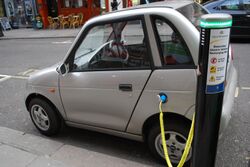
(As of January 2018), the UK had 19,108 public charging points at 6,703 locations, of which 4,391 were rapid charging points at 1,332 locations.[6] According to the National Chargepoint Registry, in 2017 there were over 25 network operators (charge point owners, branded networks, such as POLAR and charge point controllers, such as Chargemaster) at a national and regional basis.[74] (As of January 2019), the regions with most of the infrastructure are Greater London (22.3%), Scotland (14.6%), South East (14.1%), South West (8.5%), North West (7.0%), and North East (6.7%).[6]
Regional operators include Source London, ChargePlace Scotland, Plugged-In Midlands, and eCar (for Northern Ireland).[75]
Many companies, local and regional authorities provide charging to employees and members of the public. Purchasers and lessees of electric vehicles can also claim a grant towards the installation of a charger at their home.[76]
Sales
About 455,000 light-duty plug-in electric vehicles had been registered in the UK up until February 2021, consisting of around 215,000 all-electric vehicles and 240,000 plug-in hybrids.[4] These figures includes a significant number of registered plug-in electric cars and vans which were not eligible for the grant schemes.[4] Before the market launch of highway-capable mass production plug-in electric cars in 2010, a total of 1,096 electric vehicles were registered in the country between 2006 and December 2010.[77] (As of December 2019), the UK had the second largest European stock of light-duty plug-in vehicles in use after Norway.[5]
2010–2013
Electric car sales grew from 138 units in 2010 to 1,082 units during 2011.[SMMT 1][78] Before 2011, the G-Wiz quadricycle was top selling EV for several years.[79] During 2012, a total of 2,254 plug-in electric cars were registered in the UK, of which, 1,262 were pure electrics, and sales were led by the Nissan Leaf with 699 units, followed by the Toyota Prius Plug-in Hybrid with 470 units, and the Vauxhall Ampera with 455 units sold in 2012.[SMMT 2][80][81][82] In addition, 279 Renault Kangoo Z.E. electric vans and 252 Renault Twizy electric quadricycles were sold through September 2012.[83] Vehicles eligible for the Plug-in Car Grant accounted for 0.1% of total new car sales in 2012, with pure electric cars representing only 0.06%.[84]
During 2013, a total of 3,586 plug-in electric cars were registered, up 59.0% from 2012.[SMMT 3][85] Of these, 2,512 were pure electric cars, up 99.0% from 2012, and 1,072 plug-in hybrids, up 8.1% from 2012.[SMMT 3] Plug-in car sales represented a 0.16% market share of the 2.26 million new cars sold in the UK in 2013.[85] The top selling plug-in electric car during 2013 was the Nissan Leaf, with 1,812 units sold,[86] and the Prius PHV ended 2013 as the top selling plug-in hybrid with 509 units sold, up 8.5% from 2012.[85]
2014
The British market experienced a rapid growth of plug-in car sales during 2014, driven by the introduction of new models such as the BMW i3, Tesla Model S, Mitsubishi Outlander P-HEV, Renault Zoe, and Volkswagen e-Up!.[87][88][89] The number of plug-in cars available in the market climbed from 9 models in 2011 to 18 in 2013, and to 29 models by the end of 2014.[88] Registrations during 2014 totaled 14,518 plug-in electric cars and consisted of 6,697 pure electrics and 7,821 plug-in hybrids. Total registrations in 2014 were up 305% from 2013, with all-electric cars growing 167% while plug-in hybrid registrations were up 628% from a year earlier.[SMMT 4] The plug-in electric car segment captured a 0.59% market share of new car sales in 2014, over three times and a half the market share of 2013 (0.16%).[SMMT 4][86] In November 2014, with 646 all-electric cars and 1,225 plug-in hybrids registered, the segment's market share passed 1% of monthly new car sales for the first time in the UK.[90][91] Again in January 2015, the segment's market share was over 1% of new car sales with 1,715 plug-in electric cars registered that month.[92][93]
Nissan Leaf sales in September 2014 achieved a record of 851 units, up from 332 units the same month in 2013, representing not only the best monthly sales ever in the UK, but also the largest volume of Nissan Leafs ever sold in one month in a European country. The previous European record was achieved by Norway in March 2013 with 703 Leafs sold in that month.[87][96] Sales of recently introduced BMW i3 and i8 models exceeded 1,600 units during 2014.[97] The Outlander P-HEV was among the new models with a significant effect in the market, released in April 2014, it captured a 35.8% market share of total plug-in sales during the first half of 2014.[98] The Mitsubishi plug-in hybrid became the top selling plug-in electric vehicle in July 2014 and captured 43% of all applications to the Plug-in Car Grants scheme that month.[99]
The Outlander P-HEV ended 2014 as the top selling plug-in electric car in the UK that year with 5,370 units sold.[100][101] Sales of the Nissan Leaf also experienced significant growth in 2014, with 4,051 units sold, up 124% from the 1,812 units sold in 2013, and ranked as the top selling all-electric car in 2014.[89] (As of December 2014), the Leaf continued ranking as the top selling plug-in electric car in the UK ever with cumulative sales of 7,197 units since its introduction in March 2011.[86][81][89] Over 24,500 light-duty plug-in electric cars were registered in the country at the end of December 2014.[88]
2015
The surge in demand for plug-in cars continued during 2015, to the extent that 2014's ultra-low emission vehicle (ULEV) sales figure was passed in June 2015.[32] Plug-in electric car registrations in the UK totaled 28,188 units in 2015, consisting of 9,934 pure electric cars and 18,254 plug-in hybrids. Total registrations in 2015 were up 94.0% from 2014, with all-electric cars growing 48.3% year-on-year, while plug-in hybrid registrations were up 133.0% year-on-year.[SMMT 5] Since 2011, about 54,000 plug-in electric vehicles have been registered in the UK up until December 2015, including plug-in hybrids and all-electric cars, and about 2,900 commercial vans. This figure includes a significant number of registered plug-in electric cars and vans which were not eligible for the grant schemes.[102]

The plug-in electric car segment raised its market share of new car sales in 2015 to almost 1.1%, up from 0.59% in 2014.[SMMT 4][102] With almost 3,100 plug-in cars sold during December 2015, the plug-in segment reached a record of 1.7% of new car sales in the UK, the highest ever.[102] According to the British Vehicle Rental and Leasing Association (BVRLA), the market share of all new leased cars reached 4% in 2015, while a record 4.7% of all new leased cars registered during the last quarter of 2015 was a plug-in.[104]
Sales of the Mitsubishi Outlander P-HEV in the British market reached the 10,000 unit milestone in March 2015, allowing the plug-in hybrid to overtake the Leaf as the all-time top selling plug-in electric vehicle in the UK.[105][106] Sales of the Nissan Leaf sales passed the 10,000 unit milestone in June 2015.[107] The top selling models in 2015 were the Outlander P-HEV with 11,681 units registered, up 118% from 2014, followed by the Leaf with 5,236 units (up 29%), and the BMW i3 with 2,213 units (up 59%).[108]
(As of December 2015), cumulative sales of the Outlander P-HEV, the top selling plug-in car in the UK ever, totaled 17,045 units registered,[108] and cumulative sales of the Nissan Leaf, the top selling all-electric car ever, totaled 12,433 units registered.[86][108][81][89] Combined sales of the Outlander PHEV and the Nissan Leaf represent more than 50% of the British stock of plug-in electric cars sold since 2011.[109]
2016
Plug-in car sales in March 2016 achieved the best monthly plug-in sales volume on record ever, with 7,144 grant eligible cars registered, exceeding the previous high of 6,104 units, recorded in March 2015.[110][111] The plug-in market share during this month reached 1.37% of total UK new car registrations, continuing the trend for the fifth month running of sales equal of or exceeding the 1.3% market share threshold.[111] The surge in March sales was expected as a result of the changes in the Plug-in Car Grant scheme, which now provides a stronger incentive for pure electrics over plug-in hybrids, as the grant amount available for purchase of both types of powertrain was reduced, but the grant for plug-in hybrids was cut by half.[111]
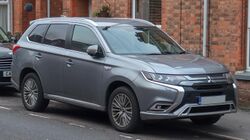
During the first quarter of 2016, Outlander P-HEV sales totalled 3,906 units, representing 52.3% of all plug-in hybrid registered in the UK during the quarter.[113] By early April 2016, two years since launch, there were 21,053 Outlander P-HEVs in the UK's roads, and the plug-in SUV sales represent 36.2% of the 58,186 eligible cars registered since the grant scheme was introduced in January 2011.[113][114] The sustained demand for plug-in cars over the previous 12 months through March 2016, has allowed the UK to become a leading market in the European Union for electric vehicles, ranking as the second biggest market after the Netherlands in terms of total plug-in car registrations, with 28,715 new units representing 20% of the European Union's collective plug-in sales.[110]
Registrations during the first six months of 2016 recorded the highest-volume half-year ever for plug-in electric car registrations.[115] A total of 19,252 plug-in electric cars were registered in the UK between January and June 2016.[SMMT 9] During the first half of 2016, the Mitsubishi Outlander PHEV was the top-selling plug-in car in the UK with 5,738 units registered. The Nissan Leaf remained the top-selling pure-electric car with 2,336 registrations.[115]
A total of 37,092 plug-in electric vehicles were registered in 2016, of which, 35,447 cars were eligible for the Plug-in Car Grant. Registrations consisted of 10,264 all-electric cars, up 3.3% from 2015, and 26,828 plug-in hybrids, up 41.9% from the previous year.[SMMT 7] Sales of plug-in hybrids oversold pure electric cars, with the latter more than doubling sales of battery electric models.[SMMT 6][116] The plug-in car segment's market share reached 1.37% of new car sales in 2016.[SMMT 6] While overall new car registrations year-to-date increased 2.3% from the same period in 2015, total plug-in car registrations in 2016 increased 28.6% from a year earlier.[SMMT 6] The Outlander P-HEV continued to lead sales of the plug-in electric segment in 2016 with 9,486 units delivered. The Leaf remained as the top selling all-electric car with 4,463 units registered. The other best selling models were the Mercedes-Benz C 350 e (4,934), BMW 330e (3,499), and the BMW i3 (2,450).[117]
By mid-October 2016, sales of the Outlander P-HEV passed the 25,000 unit mark, accounting for about 50% of all plug-in hybrid sold in the UK since 2010.[118] (As of December 2016), the Outlander plug-in hybrid continued ranking as the all-time top selling plug-in electric car in the UK, with 26,600 units sold since its inception.[112] Cumulative sales of the Nissan Leaf, the second all-time best selling plug-in car and top selling all-electric car ever, passed the 15,000 unit mark in September 2016.[94] Ranking third is the BMW i3, with almost 6,000 units sold since its inception in late 2013 through October 2016.[103]
2017
Registration of plug-in cars totaled 8,087 units in March 2017, surpassing the previous sales record achieved in March 2016 (7,534).[119][120] In addition to the normal annual sales peak caused by the plate change, consumers rushed to complete purchases to avoid the new vehicle excise duty (VED) rates that came into force from 1 April for petrol-powered vehicles priced more than £40,000, including all plug-in hybrid models.[120] The plug-in electric car segment reached a market share of 1.44% of new car sales in March 2017.[119] Registrations during the first quarter of 2017 totaled 12,071 plug-in cars, consisting of 4,634 all-electric cars and 7,437 plug-in hybrids, achieving a record market share of 1.47% for that quarter.[119]
Registrations totalled 49,182 plug-in cars in 2017, up 33% from 2016, and consisting of 35,585 plug-in hybrids and 13,597 all-electric cars, representing a market share of 1.94% of total new registrations.[SMMT 8]
2018
Registrations totalled 59,911 plug-in electric cars in 2018, up 22% from 2017, and consisting of 44,437 plug-in hybrids and 15,474 all-electric cars, representing a market share of 2.53% of total new registrations.[SMMT 8] (As of September 2018), the Mitsubishi Outlander P-HEV continued to rank as the most popular plug-in car, with almost 37,000 units registered, followed by the all-electric Nissan Leaf with almost 24,000 units.[4]
2019
(As of December 2019), the RAC foundation reported the stock of all-electric cars in use was led by the Nissan Leaf with 28,395 units, followed by the Tesla Model 3 with 10,572, the Renault Zoe with 9,929, and the Tesla Model S with 9,534.[121]
2020
(As of September 2020), the Mitsubishi Outlander P-HEV is the all-time top selling plug-in car in the UK 47,447 units registered, followed by the Nissan Leaf with 33,492 and the Tesla Model 3 with 25,574.[122]
Top selling models by year
The following table presents annual registrations of plug-in electric cars and vans by model between 2010 and 2013, and total registrations (cumulative) by model at the end of December 2014, and at the end of June 2016.
| Model | Total registered at the end of[lower-roman 1] |
Registrations by year between 2010 and December 2013[82][85][89][123][124] | |||||
|---|---|---|---|---|---|---|---|
| 2Q 2016[125] | 2015[126] | 2014[127] | 2013 | 2012[SMMT 2] | 2011[SMMT 1] | 2010 | |
| Mitsubishi Outlander P-HEV | 21,708 | 16,100 | 5,273 | ||||
| Nissan Leaf | 12,837 | 11,219 | 6,838 | 1,812 | 699 | 635 | |
| BMW i3 | 4,457 | 3,574 | 1,534 | NA[lower-roman 2] | |||
| Renault Zoe | 4,339 | 3,327 | 1,356 | 378 | |||
| Mercedes-Benz C350 e | 3,337 | 628 | 0 | ||||
| Tesla Model S | 3,312 | 2,087 | 698 | ||||
| Volkswagen Golf GTE | 2,657 | 1,359 | 0 | ||||
| Toyota Prius PHV | 1,655 | 1,580 | 1,324 | 509 | 470 | ||
| Audi A3 e-tron | 1,634 | 1,218 | 66 | ||||
| Nissan e-NV200 | 1,487 | 1,047 | 399 | ||||
| BMW 330e iPerformance | 1,479 | ||||||
| BMW i8 | 1,307 | 1,022 | 279 | ||||
| Vauxhall Ampera | 1,267 | 1,272 | 1,169 | 175 | 455 | 4 | |
| Volvo XC90 T8 | 813 | 38 | |||||
| Renault Kangoo Z.E | 785 | 740 | 663 | ||||
| Porsche Panamera S E-Hybrid | 475 | 395 | 241 | ||||
| Volvo V60 Plug-in Hybrid | 410 | 337 | 232 | ||||
| Peugeot iOn | 405 | 374 | 368 | 26[lower-roman 3] | 251 | 124 | |
| Mercedes-Benz B-Class Electric Drive | 303 | 162 | 0 | ||||
| Mitsubishi i MiEV | 252 | 251 | 266 | 1[lower-roman 3] | 107 | 125 | 27 |
| Smart electric drive | 215 | 212 | 205 | 3[lower-roman 3] | 13 | 63 | |
| Citroën C-Zero | 213 | 167 | 202 | 45[lower-roman 3] | 110 | 46 | |
| Kia Soul EV | 193 | 145 | 20 | ||||
| BMW 225xe | 163 | ||||||
| Volkswagen e-Up! | 154 | 142 | 118 | ||||
| Mercedes-Benz S500 PHEV | 125 | 157 | 14 | ||||
| Volkswagen e-Golf | 123 | 114 | 47 | ||||
| Chevrolet Volt | 119 | 122 | 124 | 23[lower-roman 3] | 67 | ||
| Renault Fluence Z.E. | 79 | 70 | 73 | 7[lower-roman 3] | 67 | ||
| Ford Focus Electric | 22 | 19 | 19 | ||||
| Mercedes-Benz Vito E-Cell | 22 | 23 | 23 | ||||
| Mia electric | 15 | 15 | 14 | ||||
| Volkswagen Passat GTE | 1 | ||||||
| BYD e6 | 0 | 0 | 0 | 50[lower-roman 3] | |||
| Total registrations[SMMT 1][SMMT 2][77][128][127][SMMT 9] | 66,374 | 47,920 | 21,504 | 3,586 | 2,254 | 1,082 | 138 |
| Notes: NA: not available. Registrations figures seldom correspond to same sales figure. | |||||||
See also
- Electric car use by country
- Government incentives for plug-in electric vehicles
- List of modern production plug-in electric vehicles
- Neale (electric car)
- New energy vehicles in China
- Plug-in electric vehicle
- Plug-in electric vehicles in Australia
- Plug-in electric vehicles in California
- Plug-in electric vehicles in Canada
- Plug-in electric vehicles in Europe
- Plug-in electric vehicles in France
- Plug-in electric vehicles in Germany
- Plug-in electric vehicles in Japan
- Plug-in electric vehicles in the Netherlands
- Plug-in electric vehicles in Norway
- Plug-in electric vehicles in Sweden
- Plug-in electric vehicles in the United States
- Renewable energy in the United Kingdom
References
- ↑ 1.0 1.1 1.2 1.3 Society of Motor Manufacturers and Traders (SMMT) (2012-01-06). "December 2011 –EV and AFV registrations". SMMT. http://www.smmt.co.uk/2012/01/december-2011-%E2%80%93-ev-and-afv-registrations/. Retrieved 2012-01-14.
- ↑ 2.0 2.1 2.2 2.3 Society of Motor Manufacturers and Traders (SMMT) (2013-01-07). "December 2012 – EV and AFV registrations". SMMT. http://www.smmt.co.uk/2013/01/december-2012-%E2%80%93-ev-and-afv-registrations/. Retrieved 2013-02-16.
- ↑ 3.0 3.1 3.2 3.3 3.4 Society of Motor Manufacturers and Traders (SMMT) (2014-01-07). "December 2013 – EV registrations". SMMT. http://www.smmt.co.uk/2014/01/december-2013-ev-registrations/. Retrieved 2014-01-12..
- ↑ 4.0 4.1 4.2 4.3 4.4 Society of Motor Manufacturers and Traders (SMMT) (2015-01-07). "December 2014 – EV registrations". SMMT. http://www.smmt.co.uk/2015/01/december-2014-ev-registrations/. Retrieved 2015-01-27.
- A total of 14,518 plug-in electric cars were registered during 2014, consisting of 6,697 pure electrics and 7,821 plug-in hybrids, up from 3,586 plug-in electric cars were registered in 2013. A total of 2,476,435 new cars were registered in 2014.
- ↑ 5.0 5.1 Society of Motor Manufacturers and Traders (SMMT) (2016-01-07). "December 2015 – EV registrations". SMMT. http://www.smmt.co.uk/2016/01/december-2015-ev-registrations/. Retrieved 2016-01-21.
- A total of 28,188 plug-in electric cars were registered during 2015, consisting of 9,934 pure electrics and 18,254 plug-in hybrids. A total of 2,633,503 new cars were registered in 2015. There have been 47,690 cars registered eligible to the Plug-In Car Grant.
- ↑ 6.0 6.1 6.2 6.3 Society of Motor Manufacturers and Traders (SMMT) (2017-01-05). "December 2016 – EV registrations". SMMT. https://www.smmt.co.uk/2017/01/december-2016-ev-registrations/. Retrieved 2017-01-09.
- Registrations in 2016 totaled 36,907 plug-in electric vehicles consisting of 10,264 all-electric cars and 26,643 plug-in hybrids. Of these, a total of 35,447 cars were eligible for the Plug-in Car Grant. Since its launch in 2011, a total of 83,052 cars eligible for the PICG have been registered through December 2016. A total of 2,692,786 new cars were registered in 2016, resulting in a plug-in electric car market share of 1.37% of new car sales.
- ↑ 7.0 7.1 7.2 Society of Motor Manufacturers and Traders (SMMT) (2018-01-05). "December 2017 – EV registrations". SMMT. https://www.smmt.co.uk/2018/01/december-ev-registrations/. Retrieved 2018-01-11.
- Registrations in 2017 totaled 47,263 plug-in electric vehicles consisting of 13,597 all-electric cars and 33,6663 plug-in hybrids. Of these, a total of 45,187 cars were eligible for the Plug-in Car Grant. Since its launch in 2011, a total of 127,509 cars eligible for the PICG have been registered through December 2017. A total of 2,540,617 new cars were registered in 2017, resulting in a plug-in electric car market share of 1.86% of new car sales.
- ↑ 8.0 8.1 8.2 8.3 8.4 Society of Motor Manufacturers and Traders (SMMT) (2019-01-07). "December 2018 – EV registrations". SMMT. https://www.smmt.co.uk/2019/01/december-ev-registrations-2/. Retrieved 2019-01-17.
- Registrations in 2018 totaled 59,911 plug-in electric vehicles consisting of 15,474 all-electric cars and 44,437 plug-in hybrids. A total of 2,367,147 new cars were registered in 2018, resulting in a plug-in electric car market share of 2.53% of new car sales.
- ↑ 9.0 9.1 Society of Motor Manufacturers and Traders (SMMT) (2016-07-06). "June 2016 – EV registrations". SMMT. http://www.smmt.co.uk/2016/07/june-2016-ev-registrations/. Retrieved 2016-07-15.
- A total of 19,252 plug-in electric cars were registered during the first half of 2016, consisting of 5,267 pure electrics and 13,985 plug-in hybrids. A total of 1,420,636 new cars were registered between January and June 2016, resulting in a plug-in electric car market share of 1.36% of new car sales.
- ↑ "December – EV registrations". 7 January 2020. https://www.smmt.co.uk/2020/01/december-ev-registrations-3/.
- ↑ "UK automotive looks to green recovery strategy after −29.4% fall in new car registrations in 2020". 6 January 2021. http://www.smmt.co.uk/2021/01/uk-automotive-looks-to-green-recovery-strategy-after-29-4-fall-in-new-car-registrations-in-2020/.
- ↑ 3.0 3.1 Henry Foy (2013-12-15). "Spending to encourage use of electric cars falls flat". Financial Times. http://www.ft.com/intl/cms/s/0/df62a896-6566-11e3-a27d-00144feabdc0.html?siteedition=intl#axzz2nh6otuJD.
- ↑ 4.0 4.1 4.2 4.3 4.4 Lane, Ben (2021-03-10). "Electric car market statistics". UK: Next Green Car. http://www.nextgreencar.com/electric-cars/statistics/.
- ↑ 5.0 5.1 International Energy Agency (IEA), Clean Energy Ministerial, and Electric Vehicles Initiative (EVI) (June 2020). "Global EV Outlook 2020: Enterign the decade of electric drive?". IEA Publications. https://www.iea.org/reports/global-ev-outlook-2020. Retrieved 2020-06-15. See Statistical annex, pp. 247–252 (See Tables A.1 and A.12).
- ↑ 6.0 6.1 6.2 "Charging point statistics 2019". https://www.zap-map.com/statistics/. Retrieved 2019-01-17.
- ↑ "Electric cars in Britain", Every car in Sweden electric by 2030, Environmental Transport Association, 2009-04-01, http://www.eta.co.uk/Every-car-in-Sweden-electric-by-2030/node/11951, retrieved 2009-04-12
- ↑ 8.0 8.1 Liew, Jonathan (2009-04-09), "Glasgow in the driving seat to take the lead in electric car revolution", Glasgow Herald, http://www.heraldscotland.com/news/12386945.Glasgow_in_the_driving_seat_to_take_the_lead_in_electric_car_revolution/, retrieved 2015-10-17
- ↑ 9.0 9.1 Jha, Alok (2009-09-04), "London mayor – 100,000 electric cars for capital", The Guardian, https://www.theguardian.com/environment/2009/apr/08/electric-cars-boris-johnson-london, retrieved 2009-04-12
- ↑ 10.0 10.1 "Only 3% of mayor's target met on electric vehicles". BBC News. 2014-06-22. https://www.bbc.com/news/uk-england-london-27955893.
- ↑ Greater London Authority (2015-10-15). "Japanese firm hails London 'electric car' capital" (Press release). London: Greater London Authority. Archived from the original on 23 November 2015. Retrieved 2015-10-17.
- ↑ 12.0 12.1 "Nissan Leaf electric car to be built in Sunderland". BBC News. 2010-03-18. http://news.bbc.co.uk/1/hi/business/8573724.stm.
- ↑ "Third Factory For 2011 Nissan Leaf Production Is Smart Move In EV Production War". AllCarsElectric.com. 2010-03-19. http://www.allcarselectric.com/blog/1043590_third-factory-for-2011-nissan-leaf-production-is-smart-move-in-ev-production-war. Retrieved 2010-03-19.
- ↑ Smith, Mark (9 April 2009), "North-east could become world leader in developing green cars", The Guardian, https://www.theguardian.com/uk/2009/apr/09/5, retrieved 2009-04-12
- ↑ Sebastian Blanco (2013-03-28). "Nissan starts 2013 Leaf production in UK, EV now made on three continents". autoblog Green. http://green.autoblog.com/2013/03/28/nissan-starts-2013-leaf-production-in-uk-ev-now-made-on-three-c/. Retrieved 2013-03-28. See Press Release.
- ↑ Nick Gibbs (2012-04-12). "Nissan Leaf EV to be restyled for European tastes". Automotive News Europe. http://europe.autonews.com/apps/pbcs.dll/article?AID=/20120412/ANE/120419963. Retrieved 2012-04-13.
- ↑ Jay Cole (2013-03-28). "Nissan LEAF Production Starts At 3rd Assembly Plant In Sunderland, UK (Factory Video)". http://insideevs.com/nissan-leaf-production-starts-at-3rd-assembly-plant-in-sunderland-uk-factory-video/. Retrieved 2013-03-29.
- ↑ Chris Tighe (2013-01-23). "Nissan cuts price of all-electric Leaf". Financial Times. http://www.ft.com/intl/cms/s/0/83937bd8-657d-11e2-a17b-00144feab49a.html#axzz2OtMdmJSJ.
- ↑ Eric Loveday (2013-04-11). "Nissan to Offer Battery Lease Option on LEAF in Europe; Complete Pricing Details Announced". InsideEVs.com. http://insideevs.com/nissan-to-offer-battery-lease-option-on-leaf-in-europe-complete-pricing-details-announced/. Retrieved 2013-04-13.
- ↑ Danny King (2013-04-12). "Nissan Leaf battery lease available in UK for £70 a month". Autoblog Green. http://green.autoblog.com/2013/04/12/nissan-leaf-battery-lease-uk/. Retrieved 2013-04-13.
- ↑ Mark Kane (2013-04-22). "Sweden and UK Drive Growth Of CHAdeMO Chargers In Europe To 1,117". InsideEVs.com. http://insideevs.com/sweden-uk-driving-growth-chademo-chargers-europe-1117/. Retrieved 2014-04-28.
- ↑ Nick Gibbs (2014-01-31). "Government commits to electric cars". The Telegraph (UK). https://www.telegraph.co.uk/motoring/green-motoring/10607357/Government-commits-to-electric-cars.html.
- ↑ Edward Wirgman (2014-07-18). "Govt fleets funded to introduce EVs". Next Green Car. http://www.nextgreencar.com/news/6710/Govt-fleets-funded-to-introduce-EVs.
- ↑ Guardian Staff (2019-10-13). "Labour party pledges to ban sale of non-electric cars by 2030" (in en-GB). The Observer. ISSN 0029-7712. https://www.theguardian.com/environment/2019/oct/13/labour-pledges-to-ban-sale-of-petrol-diesel-cars.
- ↑ "Green light to ultra low carbon car consumer incentive". Department for Transport. 2010-07-28. http://nds.coi.gov.uk/content/detail.aspx?NewsAreaId=2&ReleaseID=414706&SubjectId=16&AdvancedSearch=true. Retrieved 2011-07-21.
- ↑ "Transport Secretary Philip Hammond confirmed today that motorists will receive up to £5,000 towards purchase of an ultra-low carbon car from January 2011". Department for Transport. 2010-07-28. http://nds.coi.gov.uk/content/Detail.aspx?ReleaseID=414706&NewsAreaID=2. Retrieved 2010-07-31.
- ↑ Richard Scott (2010-07-27). "Electric car subsidy spared cuts by government". BBC News. https://www.bbc.co.uk/news/business-10783287.
- ↑ 28.0 28.1 28.2 28.3 "UK Government Announces £5,000 Grants Towards Purchase of Electric Drive Vehicles and First "Plugged-in Places"". Green Car Congress. 2010-02-26. http://www.greencarcongress.com/2010/02/uk-ev-20100226.html.
- ↑ 29.0 29.1 29.2 "Plug-in car grant eligibility guidance". Department for Transport. February 2015. https://www.gov.uk/government/publications/plug-in-car-grant/plug-in-car-grant-vehicles. Retrieved 2015-02-16.
- ↑ 30.0 30.1 30.2 Nikki Gordon-Bloomfield (2015-02-13). "UK Government Announces Changes to Plug-in Car Incentives, Introduces Banding Based on ZEV Capabilities". Transport Evolved. https://transportevolved.com/2015/02/13/uk-government-announces-changes-plug-car-incentives-introduces-banding-based-zev-capabilities/. Retrieved 2015-02-16.
- ↑ Department for Transport, Office for Low Emission Vehicles and Baroness Krame (2015-02-13). "Take-up of plug-in car grant continues to rise – Number of ultra-low emission vehicles breaks 25,000 barrier.". UK Government. https://www.gov.uk/government/news/take-up-of-plug-in-car-grant-continues-to-rise. Retrieved 2015-02-14.
- ↑ 32.0 32.1 Chris Lilly (2015-08-26). "Plug-in Car Grant scheme extended". UK: Next Green Car. http://www.nextgreencar.com/news/7192/plugin-car-grant-scheme-extended/. Retrieved 2015-10-17.
- ↑ Mike Millikin (2015-08-26). "UK extends current levels of the Plug-in Car Grant to at least February 2016". Green Car Congress. http://www.greencarcongress.com/2015/08/20150826-uk.html. Retrieved 2015-10-17.
- ↑ 34.0 34.1 34.2 34.3 Department for Transport (DfT) (2014-02-03). "Plug-in Van Grant". DfT. https://www.gov.uk/government/publications/plug-in-van-grant. Retrieved 2014-08-17. (As of June 2013), 637 claims have been made through the plug-in van grant program.
- ↑ 35.0 35.1 "Plug-in car grant extended to 2018". The Guardian. 2015-12-17. https://www.theguardian.com/business/2015/dec/17/plug-in-car-grant-extended-to-2018.
- ↑ 36.0 36.1 36.2 Chris Lilly (2015-12-17). "Extension announced for Plug-in Car Grant". UK: Next Green Car. http://www.nextgreencar.com/news/7409/extension-announced-for-plugin-car-grant/. Retrieved 2015-12-20.
- ↑ 37.0 37.1 37.2 37.3 "£4 million boost to help businesses switch vans and trucks to electric". InvestInUK. October 2016. http://www.investinuk.net/news/%C2%A34-million-boost-help-businesses-switch-vans-and-trucks-electric. Retrieved 2016-10-29.
- ↑ RAC Foundation. "Plug-in car grant claims". https://www.racfoundation.org/data/plug-in-car-grant-claims-data-page. Retrieved 2019-01-17.
- ↑ RAC Foundation. "Plug-in van grant claims". https://www.racfoundation.org/data/plug-in-van-grant-claims-data-page. Retrieved 2019-01-17.
- ↑ "Changes to the Plug-in Car Grant" (in en). Office for Low Emission Vehicles. 2 November 2018. https://www.gov.uk/government/publications/plug-in-car-grant-changes-to-grant-level-november-2018/upcoming-changes-to-the-plug-in-car-grant.
- ↑ "Update on plug-in vehicle grants following today's budget" (in en). Office for Low Emission Vehicles. 11 March 2020. https://www.gov.uk/government/news/plug-in-vehicle-grants-update-following-todays-budget.
- ↑ "Summary of the Plug-in Car Grant Eligibility Criteria". Department for Transport. http://assets.dft.gov.uk/eligibility-criteria-summary.pdf. Retrieved 2011-07-21.
- ↑ 43.0 43.1 UK Government (2016-10-25). "Plug-in car and van grants – Eligible vehicles by category". UK Government. https://www.gov.uk/plug-in-car-van-grants/eligibility. Retrieved 2016-10-29.
- ↑ RAC Foundation (February 2017). "Claims made through the Plug-in Van Grant scheme". UK: RAC Foundation. http://www.racfoundation.org/data/plug-in-van-grant-claims-data-page. Retrieved 2017-02-24. See graph with PIVG cumulative claims and claims by quarter.
- ↑ "Domestic chargepoint grant: Guidance for chargepoint suppliers". Office for Low Emission Vehicles. 1 March 2013. https://www.gov.uk/government/uploads/system/uploads/attachment_data/file/137860/domestic-chargepoint-suppliers-guidance.pdf.
- ↑ "Update on the infrastructure grants schemes" (in en). Office for Low Emission Vehicles. 12 March 2020. https://www.gov.uk/government/news/update-on-the-infrastructure-grants-schemes.
- ↑ "Thousands of electric car charging points due". Which?. 2009-11-20. http://www.which.co.uk/news/2009/11/thousands-of-electric-car-charging-points-due-189176. Retrieved 2009-11-22.
- ↑ "Recharging infrastructure". Department for Transport. http://www.dft.gov.uk/topics/sustainable/olev/recharging-electric-vehicles/. Retrieved 2011-12-06.
- ↑ "Archived copy". http://www.sourceeast.net/.
- ↑ "sourcelondon.net". https://www.sourcelondon.net/.
- ↑ "Plugged in Places". http://www.cenex.co.uk/programmes/plugged-in-places.
- ↑ "Milton Keynes « Chargemaster". http://chargemasterplc.com/charging-schemes/milton-keynes/. Retrieved 2012-03-30.
- ↑ "Charge Your Car". http://www.chargeyourcar.org.uk/indexx3.php. Retrieved 2012-03-30.
- ↑ "Electric vehicles | nidirect". 11 November 2015. https://www.nidirect.gov.uk/articles/electric-vehicles.
- ↑ "Search". https://www.gov.uk/search/all.
- ↑ Transport for London (February 2015). "Discounts and exemptions – Ultra Low Emission Discount (ULED)". Transport for London. http://www.tfl.gov.uk/modes/driving/congestion-charge/discounts-and-exemptions?intcmp=4368. Retrieved 2015-02-15. Click on "Ultra Low Emission Discount (ULED)" for details.
- ↑ Go Ultra Low (February 2016). "Vehicle technologies – Plug-in hybrids". Go Ultra Low. https://www.goultralow.com/what-are-go-ultra-low-cars/types-of-vehicles/plug-in-hybrid/. Retrieved 2016-02-03.
- ↑ "London to introduce new Ulta Low Emission Discount for Congestion Charge scheme; countering dieselization". Green Car Congress. 24 April 2013. http://www.greencarcongress.com/2013/04/uled-20130424.html. Retrieved 24 April 2013.
- ↑ "London tightens up congestion charge in attempt to drive out diesel". The Guardian. 24 April 2013. https://www.theguardian.com/environment/2013/apr/24/pollution.
- ↑ Faye Sunderland (1 July 2013). "London tightens Congestion Charge exemptions". The Green Car Website (UK). http://www.thegreencarwebsite.co.uk/blog/index.php/2013/07/01/london-tightens-congestion-charge-exemptions/. Retrieved 1 July 2013.
- ↑ "New green discount for the congestion charge comes in". BBC News. 2013-07-01. https://www.bbc.co.uk/news/uk-england-london-23125082.
- ↑ "Mayoral Decision 2397: Amendments to the Congestion Charge and Low Emission Zone". 17 December 2018. https://www.london.gov.uk/decisions/md2397-amendments-congestion-charge-and-ultra-low-emission-zone. Retrieved 2019-01-17.
- ↑ "smart fortwo electric drive Debuts in the US". Green Car Congress. 2010-06-09. http://www.greencarcongress.com/2010/06/smartus-20100609.html#more. Retrieved 2010-06-09.
- ↑ Andrew Anthony (2009-03-21). "Smart Fortwo Ed: Is the future a Smart one?". The Guardian. https://www.theguardian.com/technology/2009/mar/21/smart-fortwo-ed.
- ↑ Webster, Ben (30 April 2009), "Electric Citroën C1 car is ready, but government grants are not", The Times (London), http://business.timesonline.co.uk/tol/business/industry_sectors/transport/article6194754.ece, retrieved 2009-04-30
- ↑ Four-seater electric car unveiled, BBC News, 30 April 2009, http://news.bbc.co.uk/1/hi/england/beds/bucks/herts/8026380.stm, retrieved 2009-04-13
- ↑ Parrott, Vicky (30 April 2009), "Car Reviews – First Drive", Autocar, http://www.autocar.co.uk/CarReviews/FirstDrives/ECC-C1-Ev%27ie-30kw/239834/, retrieved 2009-04-30
- ↑ "The Electric Car Corporation Launches the Citroën C1 ev'ie – The UK's First 4 Seat All-Electric Production Car", theautochannel.com, 30 April 2009, http://www.theautochannel.com/news/2009/04/29/458863.html, retrieved 2009-04-30
- ↑ 69.0 69.1 69.2 "BMW Group releases results of UK-supported EV trial". Green Car Congress. 2011-08-05. http://www.greencarcongress.com/2011/08/minie-20110805.html. Retrieved 2011-08-08.
- ↑ 70.0 70.1 "Prime Minister backs MINI E trials". Oxford Brookes University. 2009-12-16. http://www.brookes.ac.uk/about/news/mini-e-with-pm. Retrieved 2010-06-18.
- ↑ "BMW Delivers 40 Electric MINI E Cars for UK Trial". Green Car Congress. 2009-12-14. http://www.greencarcongress.com/2009/12/minie-20091214.html. Retrieved 2009-12-25.
- ↑ Anthony ffrench-Constant (2009-10-29). "MINI E review: The all-electric version of the MINI is being trialled in Britain". The Daily Telegraph. https://www.telegraph.co.uk/motoring/green-motoring/6452749/MINI-E-review.html. Retrieved 2010-06-18.
- ↑ Antony Ingram (2012-03-26). "BMW's Low-Emissions Olympic Fleet Lands In London". Motor Authority. http://www.greencarreports.com/news/1074476_bmws-low-emissions-olympic-fleet-lands-in-london.
- ↑ "NCR Statistics: Activity by Network". 2017-09-06. http://www.national-charge-point-registry.uk/network-activity/.
- ↑ "Public charging networks". https://www.zap-map.com/charge-points/public-charging-point-networks/. Retrieved 2015-10-15.
- ↑ "Grant schemes for electric vehicle charging infrastructure". https://www.gov.uk/government/collections/government-grants-for-low-emission-vehicles. Retrieved 2017-07-28.
- ↑ 77.0 77.1 Society of Motor Manufacturers and Traders (SMMT) (April 2011). "Motor Industry Facts 2011". SMMT. http://www.smmt.co.uk/wp-content/uploads/Motor-Industry-Facts-2011.pdf. Retrieved 2012-01-14. Download the pdf report. Data available by year in Table: AFV Registrations, pp.15. Data shows all type of EVs, including quadricycles.
- ↑ Society of Motor Manufacturers and Traders (SMMT). "Motor Industry Facts 2012". SMMT. http://www.smmt.co.uk/wp-content/uploads/SMMT_FACTS_2012_WEBv.pdf?9b6f83. Retrieved 2013-10-10. Data available by year in Table: Alternatively-fuelled vehicle registrations by fuel type, pp.24. Data shows highway-capable EVs.
- ↑ Nikki Gordon-Bloomfield (2013-08-30). "TLC needed: Can cars like the G-Wiz still have a purpose in life?". The Green Car Website. http://www.thegreencarwebsite.co.uk/blog/index.php/2013/08/30/tlc-needed-can-cars-like-the-g-wiz-still-have-a-purpose-in-life/. Retrieved 2013-10-10.
- ↑ Society of Motor Manufacturers and Traders (SMMT) (2013). "New Car CO2 Report 2013". SMMT. http://www.smmt.co.uk/wp-content/uploads/SMMT-New-Car-CO2-Report-2013-web.pdf. Retrieved 2013-03-17. See Table 5: New car CO2 emissions and registrations by fuel type (pp.8) SMMT reports 1,262 electric cars, 522 range extenders and 470 plug-in hybrids for a total of 2,254 PEVs sold in 2012.
- ↑ 81.0 81.1 81.2 Mat Gasnier (2013-02-01). "UK Full Year 2012: Now with Top 350 All-models ranking!". Best Selling Cars Blog. http://bestsellingcarsblog.com/2013/02/01/uk-full-year-2012-now-with-top-350-all-models-ranking/. Retrieved 2013-02-16. A total of 635 Leafs were sold in 2011 and 699 in 2012.
- ↑ 82.0 82.1 Jon LeSage (2013-01-08). "Toyota Prius Plug-In wins 2012 sales battle in UK". Autoblog Green. http://green.autoblog.com/2013/01/08/toyota-prius-plug-in-wins-2012-sales-battle-in-uk/. Retrieved 2013-02-10.A total of 470 Prius PHV were sold in 2012.
- ↑ Richard Bremner (2012-11-06). "Twizy sells well, but EV sales disappoint Renault". AutoCar.com. http://www.autocar.co.uk/car-news/green-cars/twizy-sells-well-ev-sales-disappoint-renault. Retrieved 2012-11-06.
- ↑ 85.0 85.1 85.2 85.3 Faye Sunderland (2014-01-07). "Plug-in car sales boom on back of recovering car market". The Green Car Website. http://www.thegreencarwebsite.co.uk/blog/index.php/2014/01/07/plug-in-car-sales-boom-on-back-of-recovery-car-market/. Retrieved 2014-01-12. 509 Prius PHVs were sold 2013.
- ↑ 86.0 86.1 86.2 86.3 Fleet News (2014-01-23). "Nissan set a new UK sales record in 2013". Fleet News. http://www.fleetnews.co.uk/news/2014/1/23/nissan-set-a-new-uk-sales-record-in-2013/49402/. 1,812 Leafs were sold during 2013.
- ↑ 87.0 87.1 Will Nichols (2014-10-07). "UK electric car sales surge in 2014". The Guardian. https://www.theguardian.com/environment/2014/oct/07/uk-electric-car-sales-surge-in-2014.
- ↑ 88.0 88.1 88.2 Ben Lane (2015-01-12). "UK electric fleet passes 24,500 mark". UK: Next Green Car. http://www.nextgreencar.com/news/6910/UK-electric-fleet-passes-24500-mark. Retrieved 2015-01-19.
- ↑ 89.0 89.1 89.2 89.3 89.4 Will Nichols (2015-01-08). "Electric car sales quadruple during 2014". Business Green. http://www.businessgreen.com/bg/analysis/2389124/electric-car-sales-quadruple-during-2014. A total of 4,051 Leafs were sold in 2014.
- ↑ Society of Motor Manufacturers and Traders (SMMT) (2014-12-04). "November 2014 – EV registrations". SMMT. http://www.smmt.co.uk/2014/12/november-2014-ev-registrations/. Retrieved 2014-12-09.
- ↑ Mark Kane (2014-12-08). "Plug-In Electric Car Sales UK At 1% Of Market In November". InsideEVs.com. http://insideevs.com/plug-in-electric-car-sales-uk-at-1-of-market-in-november/. Retrieved 2014-12-09.
- ↑ Society of Motor Manufacturers and Traders (SMMT) (2015-02-05). "January 2015 – EV registrations". SMT. http://www.smmt.co.uk/2015/02/january-2015-ev-registrations/. Retrieved 2015-02-14.
- ↑ Mark Kane (2015-02-13). "UK Plug-in Electric Car Sales Begin 2015 At Over 1% Market Share". InsideEVs.com. http://insideevs.com/uk-plug-in-electric-car-sales-begin-2015-at-over-1-market-share/. Retrieved 2015-02-16.
- ↑ 94.0 94.1 "Cash reward celebrates 15,000th UK LEAF sale" (Press release). Nissan UK. 2016-09-14. Archived from the original on 16 September 2016. Retrieved 2016-09-15.
- ↑ Staff (2016-01-18). "Nissan electric vehicle sales soar, as industry celebrates fresh green car investment". Business Green. http://www.businessgreen.com/bg/news/2442180/nissan-electric-vehicle-sales-soar-as-industry-celebrates-fresh-green-car-investment.
- ↑ "September serves up record sales for Nissan LEAF" (Press release). UK: Nissan GB. 2014-10-06. Archived from the original on 15 October 2014. Retrieved 2014-10-09.
- ↑ "BMW Group UK reports record sales in 2014" (Press release). BMW Group PressClub United Kingdom. 2015-01-07. Archived from the original on 19 January 2015. Retrieved 2015-01-08.
- ↑ Alex Grant (2014-07-08). "Japanese manufacturers lead growing UK electric and hybrid vehicle sales". Fleet World. http://fleetworld.co.uk/news/2014/Jul/Japanese-manufacturers-lead-growing-UK-electric-and-hybrid-vehicle-sales/0434015288.
- ↑ Faye Sunderland (2014-08-06). "Mitsubishi Outlander plug-in hybrid tops UK electric car sales". UK: The Green Car Website. http://www.thegreencarwebsite.co.uk/blog/index.php/2014/08/06/mitsubishi-outlander-plug-in-hybrid-tops-uk-electric-car-sales/. Retrieved 2014-08-17.
- ↑ "Confident Mitsubishi UK Builds On Strong 2014 Sales With New Five-Year Warranty" (Press release). London: Mitsubishi Motors UK. 2015-01-07. Archived from the original on 19 January 2015. Retrieved 2015-01-19.
- ↑ Mitsubishi (January 2015). "European sales up by 28 per cent for Mitsubishi". Mitsubishi Matters UK. http://www.mitsubishi-matters.co.uk/2015/01/21/sales-28-per-cent-mitsubishi-europe/. Retrieved 2015-06-28.
- ↑ 102.0 102.1 102.2 Lane, Ben (2016-01-07). "UK plug-in car sales hit record levels". UK: Next Green Car. http://www.nextgreencar.com/news/7434/plugin-sales-hit-record-levels/. Retrieved 2016-02-03.
- ↑ 103.0 103.1 "BMW i8 and i3 showcased in the capital" (Press release). London: BMW Group PressClub United Kingdom. 2016-11-04. Archived from the original on 7 November 2016. Retrieved 2016-11-06. Close to 6,000 units of the BMW i3 have been sold in the UK since its launch in 2013.
- ↑ Kane, Mark (2016-03-21). "In UK, Plug-Ins Already Approaching 5% Market Share Of All New Leased Cars". InsideEVs.com. http://insideevs.com/in-uk-plug-ins-already-approaching-5-market-share-of-all-new-leased-cars/. Retrieved 2016-03-21.
- ↑ "Mitsubishi Outlander PHEV is the UK's Favourite Plug-In Vehicle". The Auto Channel. 2015-03-09. http://www.theautochannel.com/news/2015/03/09/126413-mitsubishi-outlander-phev-is-uk-s-favourite-plug-vehicle.html. Retrieved 2015-03-14.
- ↑ Andy Sharman (2015-03-25). "Mitsubishi's outlandish electric car success". Financial Times. http://www.ft.com/intl/cms/s/0/888a8f46-d2e0-11e4-a792-00144feab7de.html?siteedition=intl#axzz3VQkUJkKn.
- ↑ Nissan News Release (2015-07-06). "Nissan celebrates 10,000 LEAF sales in the UK". Automotive World. http://www.automotiveworld.com/news-releases/nissan-celebrates-10000-leaf-sales-uk/. A total of 2,964 Nissan Leafs were sold during the first half of 2015, and cumulative sales since the Leaf introduction totaled 10,161 units by the end of June 2015.
- ↑ 108.0 108.1 108.2 "Record-breaking year for plug-in cars". Fleet News. 2016-01-15. http://www.fleetnews.co.uk/news/manufacturer-news/2016/01/15/record-breaking-year-for-plug-in-cars.
- ↑ Lilly, Chris (2016-04-14). "Mitsubishi and Nissan dominate EV market". UK: Next Green Car. http://www.nextgreencar.com/news/7600/mitsubishi-and-nissan-dominate-ev-market/. Retrieved 2016-04-21.
- ↑ 110.0 110.1 Price, Maddy (2016-04-13). "Electric Car Registrations Reach Record High As Plug-In Popularity Continues To Grow". Fleet Point. http://www.fleetpoint.org/fleet-industry-news/news-by-date/electric-car-registrations-reach-record-high-plug-popularity-continues-grow/.
- ↑ 111.0 111.1 111.2 Lilly, Chris (2016-04-07). "Record month for EV sales". Next GreenCar UK. http://www.nextgreencar.com/news/7593/record-month-for-ev-sales/. Retrieved 2016-04-07.
- ↑ 112.0 112.1 Mitsubishi UK (2017-01-20). "Further evolution for the 2017 Mitsubishi Outlander". Automotive World. http://www.automotiveworld.com/news-releases/evolution-2017-mitsubishi-outlander/. "The Mitsubishi Outlander PHEV is the UK’s best-selling Plug-in Hybrid Electric Vehicle. At its introduction in 2014 it effectively created the ultra-low emission vehicle segment, notching up 10,000 sales in the UK within the first ten months and amassing a total sales figure of 26,600 by the end of 2016."
- ↑ 113.0 113.1 Grant, Alex (2016-04-07). "ULEV sales reach new record in March". EV Fleet World. http://evfleetworld.co.uk/news/2016/Apr/ULEV-sales-reach-new-record-in-March/0438024499.
- ↑ Staff (2016-04-05). "Two years since launch and the Mitsubishi Outlander PHEV has created a whole new market sector". Automotive World. http://www.automotiveworld.com/news-releases/two-years-since-launch-mitsubishi-outlander-phev-created-whole-new-market-sector/.
- ↑ 115.0 115.1 "Highest ever electric car uptake recorded at 2016 half-way point" (Press release). London: Go Ultra Low. 2016-08-02. Archived from the original on 16 September 2016. Retrieved 2016-08-19. The Mitsubishi Outlander PHEV was the top-selling plug-in car in the UK with 5,738 registered during the first half of 2016. The Nissan Leaf remained the top-selling pure-electric car with 2,336 first-half registrations in 2016.
- ↑ Lilly, Chris (2016-10-06). "September sales figures see boost for electric models". Next Green Car. http://www.nextgreencar.com/news/7834/september-sales-figures-see-boost-for-electric-models/.
- ↑ Pontes, Jose (2017-01-23). "UK December 2016 (Top 5 Draft)". EV Sales. http://ev-sales.blogspot.com.br/2017/01/uk-december-2016-top-5-draft.html. Retrieved 2017-01-23.
- ↑ Millikin, Mike (2016-10-14). "Sales of Mitsubishi Outlander PHEV top 25K in UK, accounting for ~50% of all PHEVs there since 2010". Green Car Congress. http://www.greencarcongress.com/2016/10/20161014-outlander.html. Retrieved 2016-10-14.
- ↑ 119.0 119.1 119.2 Society of Motor Manufacturers and Traders (SMMT) (2017-04-05). "March 2017 – EV registrations". SMMT. https://www.smmt.co.uk/2017/04/march-2017-ev-registrations/. Retrieved 2017-04-16.
- ↑ 120.0 120.1 Kane, Mark (2017-04-08). "UK Sets New Plug-In EV Sales Record In March, Over 8,000 Sold!". InsideEVs.com. http://insideevs.com/uk-sets-new-plug-in-electric-car-sales-record-in-march-over-8000/. Retrieved 2017-04-16.
- ↑ "Private pure EV cars on the road Dec2019". RAC Foundation. https://www.racfoundation.org/data/plug-in-vehicles-on-the-road.
- ↑ "Plug-in vehicles on the road". RAC Foundation. https://www.racfoundation.org/data/plug-in-vehicles-on-the-road.
- ↑ Jose Pontes (2013-10-09). "UK June 2013". EV Sales. http://www.ev-sales.blogspot.ca/2013/10/uk-june-2013.html. Retrieved 2013-10-10. 295 Prius PHVs were sold during the first half of 2013.
- ↑ Ben Lane (2015-02-10). "Nissan LEAF most popular EV in UK". UK: Next Green Car. http://www.nextgreencar.com/news/6969/nissan-leaf-most-popular-ev-in-uk. Retrieved 2015-02-14. A total of 1,039 Vauxhall Amperas, 1,029 UK BMW i3s (454 all-electric and 575 with range-extender option) and 474 Tesla Model S sedans have been registered since their introduction up until September 2014.
- ↑ RAC Foundation (September 2016). "Plug-in grant eligible vehicles licensed (at the end of Q2 2016)". UK: RAC Foundation. http://www.racfoundation.org/data/plug-in-grant-eligible-vehicles-licensed-by-quarter. Retrieved 2016-10-02.
- ↑ RAC Foundation. "Plug-in grant eligible vehicles licensed". UK: RAC Foundation. http://www.racfoundation.org/data/plug-in-grant-eligible-vehicles-licensed-by-quarter. Retrieved 2016-04-15. Figures correspond to the number of vehicles registered at the end of the corresponding quarter. For models with declining number of registered cars the highest figure from previous quarters is shown
- ↑ 127.0 127.1 RAC Foundation (2015-09-18). "Ultra-green cars – latest on-the-road figures". UK: RAC Foundation. http://www.racfoundation.org/media-centre/ultra-green-cars-on-the-road-Q2-2015-180915. Retrieved 2015-10-17. Figures correspond to the number of vehicles registered at the end of the corresponding month.
- ↑ Society of Motor Manufacturers and Traders (SMMT) (2013-07-04). "June 2013 – EV and AFV registrations". SMMT. http://www.smmt.co.uk/2013/07/jun-2013-%E2%80%93-ev-registrations/. Retrieved 2013-10-14. A total of 1,049 pure electric cars and 511 plug-in hybrids were registered during the first half of 2013.
External links
- Electrek – EV and Tesla News, Green Energy, Ebikes, and more, Electric car news and reviews.
- driveEV, UK-based electric car news, reviews and resources.
- Electric car market statistics in the UK, Next Greencar.
- EV charging point map in the UK
- Fueling British's Future, Cambridge Econometrics, March 2015.
- Go Ultra Low, official website UK campaign for ultra-low emission vehicles.
- Leading the Charge – Can Britain Develop a Global Advantage in Ultra-Low-Emission Vehicles[yes|permanent dead link|dead link}}], Institute for Public Policy Research, April 2013
- Powering Ahead – The future of low-carbon cars and fuels, the RAC Foundation and UK Petroleum Industry Association, April 2013.
- Plug-in car and van grants official website.
- Plug–in vehicles, plugged in policy?: Government Response to the Committee's Fourth Report of Session 2012–13, House of Commons of the United Kingdom, Transport Committee, January 2013.
